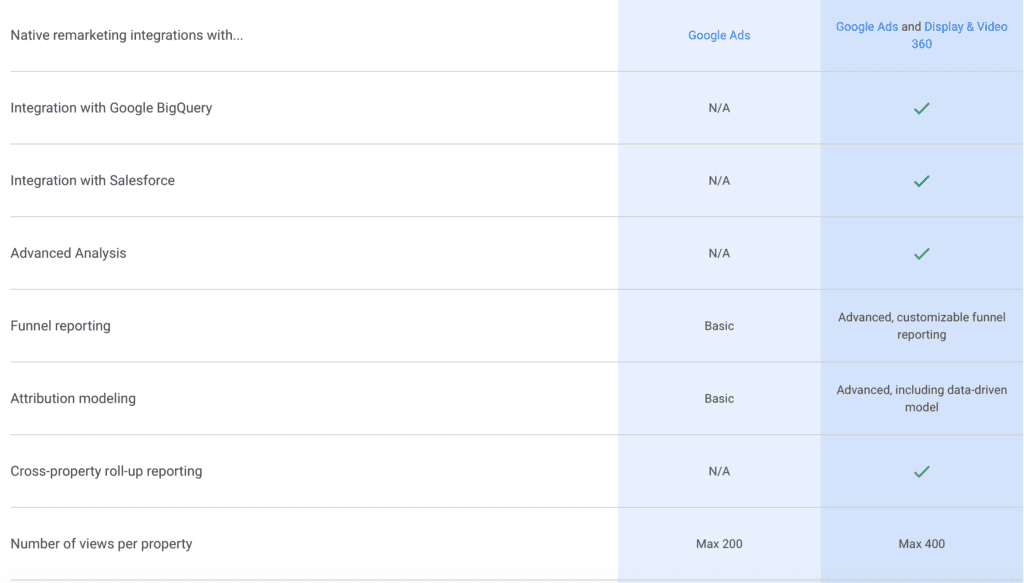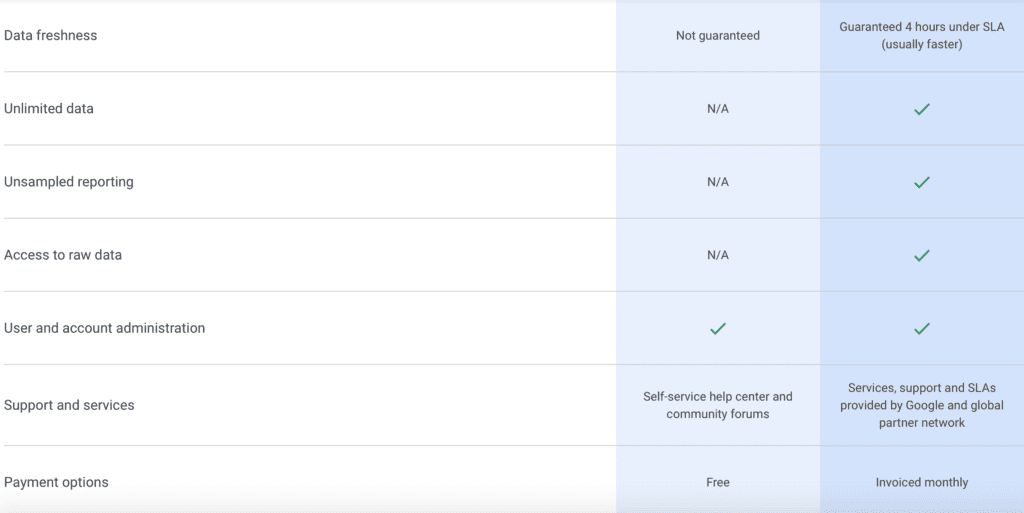Making the move to enterprise-level analytics marks a pivotal point in time for your organization. It signals a seriousness about data, and how it will inform your decision-making to shape the future of your business.
It’s also a 6-figure investment, and while it can be a decision that makes itself if your hit levels exceed 10M – which falls outside the terms and conditions of standard Google Analytics – for most organizations it requires some serious consideration.
But the upgrade from free GA to GA 360 isn’t just about data collection. The platform includes a comprehensive suite of upgraded tools that includes data visualization, testing & personalization, tag management and surveys, with Search Ads 360 and Display & Video 360 available as natively integrated features that can deliver a one-two punch of benefits. Also included with the license are monthly credits for Google BigQuery, where you can have your questions answered in the cloud or even use it as a primary data warehouse, which in itself can provide significant cost efficiencies.
Signs It’s Time to Level Up
– You make advertising decisions on an hourly basis and need consistently fresh data.
– You use either one or both Salesforce Sales and Marketing Clouds. With the powerful GA 360 integration, companies can seamlessly use lead data and customer lifetime value stored in their Sales Cloud to segment users and focus on their most valuable customers for audience creation, intelligent targeting, and personalization.
– You need access to all of your unsampled data for precise accuracy, in-depth understanding, analysis, or advanced data science projects/workflows. Or you are one of the organizations with over 1M visitors per month, which means that each month’s data is sampled below the 50% threshold.
– You require a higher level of technical support – either from Google or from a Certified GA 360 reseller, such as Cardinal Path.
– You need integration across multiple Google platforms. A GA 360 license is all-inclusive – data can be consolidated, ensuring more in-depth analysis across multiple channels, including seamless integrations across the Google enterprise stack, BigQuery and media solutions including DoubleClick, AdWords, Display Network.
– You work for a large organization that has Service Level Agreements (SLA) with vendors, and you have been unable to use GA due to its lack of an SLA. The SLA is the “peace-of-mind” solution for large-scale companies and is one that resonates strongly with any organization’s decision makers – they mean guarantees on data collection, reporting, and ownership.

ROI Assessment & Success Factors
The ROI isn’t cut and dry, since it will depend on your organization’s goals, capabilities, and an internal drive to deliver data-informed insights to teams that can apply them. In our experience across hundreds of engagements, companies that invest upwards of $1 million in their search and display advertising annually can justify the upgrade through efficiencies of just 10% of their media spend. It’s worth noting that enterprise-level analytics is not just a commodity transaction, but an investment that will pay dividends, particularly with a trend towards greater focus on 1st-party data. Companies like Panasonic have used Google Analytics 360 to improve their return on ad spend by 30%.

It’s great to have a powerful new tool, but you’ve got to know how to use it to its full potential against your business goals. Adoption doesn’t happen overnight. Technology alone isn’t going to give you a marketing boost. You’ll need the people and process to connect the dots between data, insights, and business benefits. Successful teams have a clear understanding of what they want from the tool (i.e. personalization, optimization, media spend efficiency and enhancement) and have organizational buy-in of these objectives vertically and across the organization.

Analytics is one piece – albeit a major one – of your larger digital strategy.
Read on to discover how organizations have successfully deployed and leveraged the capabilities of Google Analytics 360 to achieve their specific goals.
Using GA 360 to Understand How Online Efforts Impact Offline Conversions
When a Fortune 100 company reached out to us for marketing analytics support, the team had two goals: to drive $1 billion in digital revenue and to understand how their online efforts were influencing offline sales. With no Ecommerce function on their sites, they needed a way to know how brand marketing was impacting revenues. Once we understood their specific business goals, we began with a Google Analytics 360 (GA 360) implementation, deploying Google Tag Manager (GTM) across 14 different brands to bring in the data needed to fuel insights.
With a successful implementation in place, we built a solution using GA 360 and GTM to help them better understand the impact of their online efforts. Brand teams had no visibility into consumer behavior (redemption/date, store, etc.) after they downloaded a coupon offer through their website. We stitched online user behavior (acquisition channel, browsing behavior, site interaction) with offline user behavior (coupon redemptions major retailers including Walmart, Target, Krogers, and more).
The solution gave them a custom data upload functionality that identifies a GA client ID and reports key details – where they came from (ie. display) what they looked at, what they did on site – and ties the session back to the original source (ie. display banner from Sports Illustrated) bolstered by geographic, demographic, and limitless user details.
Hitsender Process Flow
The GA 360 implementation enabled the company to view granular detail into the shopper journey, compare downloaders and redeemers (by store, by audience – ie. millennials vs. boomers), clearly see a share of wallet trends by brand, and use these insights to get out ahead of competition. These insights helped them to gain support and buy-in from the various brands, particularly for in-store marketing efforts.
Making the leap to an enterprise-level analytics platform marked a step-change in the company’s digital maturity, serving as the cornerstone of their newly robust data-informed marketing initiatives.
Cardinal Path helped a global music corporation use GA 360 to collect behavioral data – including plays, pauses, shares, stops, forwards, sign-ins, registers, and more, from all of their streaming music partners. GA 360 allowed for an added ability to strip out data not related to their business, which meant the agency saw an accurate view of the interactions with their music and used this rich data set to remarket to people based on their activity. Traditionally in the music business, a record will launch with a single, which the label or artist hand-selected. Instead, the company made empowered, enlightened choices by using data insights from GA360 to crowdsource the next single.
GA 360 Rollup Feature for Enterprise Analytics at Scale
An American multinational corporation, active in over 180 countries, was running an outdated measurement technology, with on-page code, and no unified view of their 50+ web properties. With sites in silos, it was nearly impossible to extract business value from their digital data.
Their upgrade to Google Analytics 360 included a custom digital measurement framework and a Google Tag Manager (GTM) framework to deploy across all digital properties, both internal and external sites, globally. The GTM container was installed on the sites, and we delivered a detailed playbook for any future installation – with nearly 90% configured right out of the “box”. With solid and consistent metrics and reporting across all web properties, the organization now had a solid base from which to bring all of their global data into a single property using Google Analytics 360’s Enterprise Rollup feature.
This framework provided a tailored set of metrics and reports their analysts use to inform various stakeholders. They now have a single view of their entire digital ecosystem. Even across multiple sites, each with a different purpose and cultural characteristics, this GTM solution enables drill-down analysis, segmentation, and complete trust in their global data.
Technical benefits include ease of maintenance and comfort in the fact that with the digital measurement framework, future rollouts can be conducted in ten minutes by their own developers, and to the highest possible standard, along with all company-wide sites.
Extending the value of the data layer
Cardinal Path additionally delivered an engagement scoring solution to extend their data-driven insights. The idea is that organizations need a single ruler to measure everything that happens on the websites. They company’s stakeholders told us what was important to their business, and we helped them to better understand the weighted performance of campaigns and content engagement. Taking into account multiple stakeholders and differing perspectives across this vast enterprise, we developed a gradient scale to assign weighted values to specific site engagement actions, to ensure that they are always comparing apples to apples and working across a level playing field.
Business users benefit from a set of custom-built dashboards for ease of reporting and they are now able to glean insights into the business value of certain behaviors, quickly see audience engagement, know who is engaging with what content, and adapt their efforts accordingly no matter what the purpose of the site.
User behavior is mapped to the engagement score so they can understand what topics are important, what content is most compelling, and adjust messaging for the greatest impact.
GA 360 Unique Features & Comparison to GA Standard
A GA 360 license is all-inclusive – data can be consolidated, ensuring more in-depth analysis across multiple channels, including seamless integrations across the Google enterprise stack, BigQuery and media solutions including DoubleClick, AdWords, Display Network.
Buying Google Marketing Platform’s integrated suite together can also mean a better price on the package overall. The suite includes Google Tag Manager 360, a tag management system to more easily deploy and manage all third-party tags, from a single interface, and Google Optimize 360 – a powerful testing platform to quickly test, adapt, and personalize customer experiences.

















